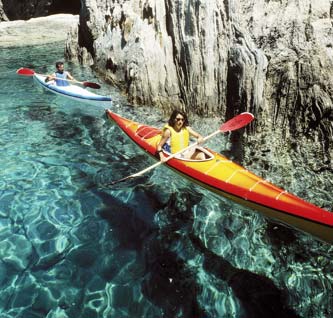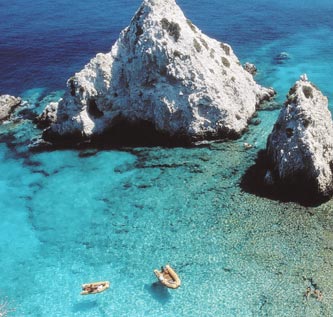Compagnia dei parchi, for sustainable tourism
Results
CDP’s innovative business model has achieved very significant results:
• It has promoted the conservation of the distinguishing values of the park areas of inland Italy, by fostering the resurgence of local pride in belonging among populations that had long been weak economically and marginalised socially.
• It has provided park authorities with new and effective operational models, so enabling them to become development “incubators” in the protected areas and not mere custodians.
• It has created local economic development, managing to generate income from properties that had been in decay.
• It has given dignity to the tourism product in the park areas. If today tourism in the parks has become a significant reality and an integral part of the “made in Italy” tourism system, this is also thanks to the work of CDP.
CDP has promoted and organised the national tourism offering, working in 16 protected areas:
• National Park of Gran Sasso and Monti della Laga – Abruzzo and Marche Regions
• National Park of Abruzzo, Lazio and Molise – Abruzzo, Lazio and Molise Regions
• Regional Park of Monte Cucco – Umbria Region
• National Park of the Monti Sibillini – Marche and Umbria Regions
• Regional Park of Sirente Velino – Abruzzo Region
• National Park of the Majella – Abruzzo Region
• Regional Nature Reserve of Zompo lo Schioppo – Abruzzo Region
• Regional Nature Reserve of Monte Genzana Alto Gizio – Abruzzo Region
• National Park of the Gargano – Puglia Region
• National Park of the Cinque Terre – Liguria Region
• National Park of the Dolomiti Bellunesi – Veneto Region
• National Park of the Foreste Casentinesi, Monte Falterona and Campigna – Emilia–Romagna and Toscana Regions
• National Park of the Pollino – Basilicata and Calabria Regions
• National Park of Vesuvio – Campania Region
• National Park of the Cilento and Vallo di Diano – Campania Region
• Regional Park of the Po Delta –- Emilia–Romagna Region
The results achieved by CDP are best described by examining its impact in the National Park of the Cilento and Vallo di Diano.
Results in the National Park of the Cilento and Vallo di Diano
The National Park of the Cilento and Vallo di Diano is located in the Campania Region and its territory comprises 80 municipalities in the Province of Salerno. The local socio-economic conditions are characterised by; a significant dependence of the local economy on transfer of income from outside the area in the form of pensions, commuting, remittances from migrants, and seasonal income flows from tourism; a limited range of productive activities, which is undoubtedly an element of structural weakness in the local economy; a rate of population growth that is well below that in the rest of the Campania Region, especially in the mountainous areas and the inland areas of the park; a significant gap between the more developed coastal communities and those in the mountains; an illiteracy rate of 6.9% (more than 10% in some inland communities); the percentage of local people with no educational qualification is 19.2% compared with 15.8% for the province as a whole; the percentage of local people with a high-school diploma is 13.3% compared with 16.2% for the province as a whole.
In the last ten years, the area has seen tourism grow by 6%. However, this growth has been mainly in the coastal areas of the Cilento, which is popular with both Italians and foreigners. In order to give the more marginalised areas a chance of developing, targeted policies were needed involving the putting together of packages that could combine the natural beauty of the sea with culture, sport and cuisine. Before CDP started its work, the hilly and mountainous areas of the park had seen little tourism. Furthermore, because of the unplanned development of small hotels and the renting out of private homes, the coastal area had been spoiled by inappropriate urban development.
CDP set up a Learning Centre for education and training to serve as a hub and catalyst for a network of outlying information centres, and as a reference point for local actors. The project has developed through:
• The setting up of a network of 8 Tourism Information Centres (TICs), that provide training, information and advice. These are scattered throughout the park area and linked to the Learning Centre. This structure has provided services to guide the management of the park in shifting away from a subsistence economy towards policies that are more in keeping with a mature economy.
• Training courses, held at the Learning Centre, for information and guidance operators, tutors, trainers, co-ordinators of the Centre and the outlying branches, so laying the basis for the effective functioning of the TIC network.
• Active involvement, with targeted information, participation at local fairs and exhibitions, and the setting up of real and virtual round-tables. 
The 8 TICs completed distance training modules, prepared by CDP and the Learning Centre, before becoming part of the CDP network. Each TIC has its own operational structure and is linked by Internet with the Learning Centre (msn messenger). In addition to IT resources, the network’s operational structures provide tourism-related information and training services. They are the operational tools of CDP, acting as intermediaries with the wide diversity of local tourism accommodation both actual (existing accommodation) and potential (accommodation that may become available for tourism purposes).
Impacts in the park area
The Learning Centre employs 2 professionals who provide training and advice. These operators develop skills and tools to activate widespread organised, network-based initiatives to foster heritage (in terms of buildings, tourism and the environment) both within and outside the local territory. The TICs employ 16 skilled operators who are in constant touch with the partners and the head of the Learning Centre to guide decisions and plan activities. The induced employment, estimated at 30 jobs, is mainly in: accommodation maintenance and management; maintenance and management of local paths and itineraries; expert guides; co-operatives that organise excursions and transfers; and communication and information activities. Overall, the direct and induced employment arising from CDP’s work in the National Park of the Cilento and Vallo di Diano totals 48 jobs. 
The CDP network has developed a supply of available accommodation for 480 tourists, and 20 weekend and weekly rental properties, by involving local authorities, social actors, and the owners of houses and other forms of accommodation. CDP has opened up the possibility of a self-sustaining development that is in keeping with the nature of the territory through marketing and a self-help enterprise culture. Its work has focused on previously neglected cultural and environmental heritage and on rediscovering local traditions, cuisine and handicrafts. Indeed, its most significant impact has been in the rediscovery of local values and in giving credibility and recognition to a lost identity. This has given local people pride in a sense of belonging and strengthened their ties to their homeland. These values are vital to the continuing of self-sustaining growth and to removing the spectre of emigration.
However, it will only be possible to quantify these impacts after CDP has further developed its activities over a longer time.
DOWNLOAD THE BROCHURE PDF
english (0.9 MB)albanian (0.5 MB)
Spanish (0.9 MB)
ONLY TEXT
•Compagnia dei Parchi in practice








 COUNTRY OF ORIGIN
COUNTRY OF ORIGIN OUTSTANDING IDEASS PROJECTS
OUTSTANDING IDEASS PROJECTS